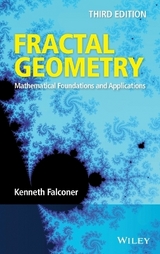
Fractal Geometry
John Wiley & Sons Ltd (Hersteller)
978-0-470-01385-4 (ISBN)
- Titel erscheint in neuer Auflage
- Artikel merken
Fractal Geometry: Mathematical Foundations and Applications is aimed at undergraduate and graduate students studying courses in fractal geometry. The book also provides an excellent source of reference for researchers who encounter fractals in mathematics, physics, engineering, and the applied sciences. Also by Kenneth Falconer and available from Wiley: Techniques in Fractal Geometry ISBN 0-471-95724-0 Please click here to download solutions to exercises found within this title: http://www.wileyeurope.com/fractal
Preface. Preface to the second edition. Course suggestions. Introduction. Notes and references. PART I: FOUNDATIONS. Chapter 1: Mathematical background. 1.1 Basic set theory. 1.2 Functions and limits. 1.3 Measures and mass distributions. 1.4 Notes on probability theory. 1.5 Notes and references. Exercises. Chapter 2: Hausdorff measure and dimension. 2.1 Hausdorff measure. 2.2 Hausdorff dimension. 2.3 Calculation of Hausdorff dimension-simple examples. 2.4 Equivalent definitions of Hausdorff dimension. 2.5 Finer definitions of dimension. 2.6 Notes and references. Exercises. Chapter 3: Alternative definitions of dimension. 3.1 Box-counting dimensions. 3.2 Properties and problems of box-counting dimension. 3.3 Modified box-counting dimensions. 3.4 Packing measures and dimensions. 3.5 Some other definitions of dimension. 3.6 Notes and references. Exercises. Chapter 4: Techniques for calculating dimensions. 4.1 Basic methods. 4.2 Subsets of finite measure. 4.3 Potential theoretic methods. 4.4 Fourier transform methods. 4.5 Notes and references. Exercises. Chapter 5: Local structure of fractals. 5.1 Densities. 5.2 Structure of 1-sets. 5.3 Tangents to s-sets. 5.4 Notes and references. Exercises. Chapter 6: Projections of fractals. 6.1 Projections of arbitrary sets. 6.2 Projections of s-sets of integral dimension. 6.3 Projections of arbitrary sets of integral dimension. 6.4 Notes and references. Exercises. Chapter 7: Products of fractals. 7.1 Product formulae. 7.2 Notes and references. Exercises. Chapter 8: Intersections of fractals. 8.1 Intersection formulae for fractals. 8.2 Sets with large intersection. 8.3 Notes and references. Exercises. PART II: APPLICATIONS AND EXAMPLES. Chapter 9: Iterated function systems-self-similar and self-affine sets. 9.1 Iterated function system. 9.2 Dimensions of self-similar sets. 9.3 Some variations. 9.4 Self-affine sets. 9.5 Applications to encoding images. 9.6 Notes and references. Exercises. Chapter 10: Examples from number theory. 10.1 Distribution of digits of numbers. 10.2 Continued fractions. 10.3 Diophantine approximation. 10.4 Notes and references. Exercises. Chapter 11: Graphs of functions. 11.1 Dimensions of graphs. 11.2 Autocorrelation of fractal functions. 11.3 Notes and references. Exercises. Chapter 12: Examples from pure mathematics. 12.1 Duality and the Kakeya problem. 12.2 Vitushkin's conjecture. 12.3 Convex functions. 12.4 Groups and rings of fractional dimension. 12.5 Notes and references. Exercises. Chapter 13: Dynamical systems. 13.1 Repellers and iterated function systems. 13.2 The logistic map. 13.3 Stretching and folding transformations. 13.4 The solenoid. 13.5 Continuous dynamical systems. 13.6 Small divisor theory. 13.7 Liapounov exponents and entropies. 13.8 Notes and references. Exercises. Chapter 14: Iteration of complex functions-Julia sets. 14.1 General theory of Julia sets. 14.2 Quadratic functions-the Mandelbrot set. 14.3 Julia sets of quadratic functions. 14.4 Characterization of quasi-circles by dimension. 14.5 Newton's method for solving polynomial equations. 14.6 Notes and references. Exercises. Chapter 15: Random fractals. 15.1 A random Cantor set. 15.2 Fractal percolation. 15.3 Notes and references. Exercises. Chapter 16: Brownian motion and Brownian surfaces. 16.1 Brownian motion. 16.2 Fractional Brownian motion. 16.3 Levy stable processes. 16.4 Fractional Brownian surfaces. 16.5 Notes and references. Exercises. Chapter 17: Multifractal measures. 17.1 Coarse multifractal analysis. 17.2 Fine multifractal analysis. 17.3 Self-similar multifractals. 17.4 Notes and references. Exercises. Chapter 18: Physical applications. 18.1 Fractal growth. 18.2 Singularities of electrostatic and gravitational potentials. 18.3 Fluid dynamics and turbulence. 18.4 Fractal antennas. 18.5 Fractals in finance. 18.6 Notes and references. Exercises. References. Index.
| Erscheint lt. Verlag | 28.1.2005 |
|---|---|
| Verlagsort | Chichester |
| Sprache | englisch |
| Maße | 163 x 234 mm |
| Gewicht | 658 g |
| Themenwelt | Mathematik / Informatik ► Mathematik ► Geometrie / Topologie |
| ISBN-10 | 0-470-01385-0 / 0470013850 |
| ISBN-13 | 978-0-470-01385-4 / 9780470013854 |
| Zustand | Neuware |
| Haben Sie eine Frage zum Produkt? |
